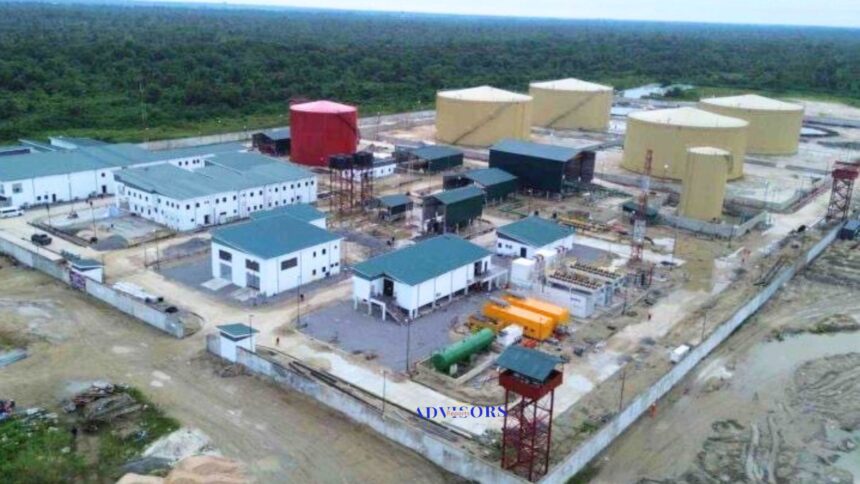… becomes second-largest after Bonny, further breaking 50-year foreign dominance in crude export
… emerges eighth major terminal in Nigeria, adds high-capacity outlet for over 40 stranded fields
Oredola Adeola
Nigeria has broken a five-decade dominance of crude evacuation and midstream infrastructure by international oil companies with the launch of the $400 million Otakikpo Oil Export Terminal, the country’s first fully indigenous onshore crude export facility and second-largest terminal in the country.
The facility owned and operated by Green Energy International Limited (GEIL) features a 750,000-barrel storage capacity (expandable to 3 million) and 360,000 barrels-per-day pumping capacity, dedicated to providing an efficient evacuation outlet for marginal and stranded fields across the region.
The facility, located in Ikuru Town, Andoni Local Government Area of Rivers State, was commissioned on Wednesday by President Bola Tinubu, who was represented by Senator Heineken Lokpobiri Minister of State for Petroleum Resources (Oil).
President Bola Tinubu said the new terminal would also function as a key evacuation route for crude oil produced from Ogoniland and nearby fields, helping to strengthen regional output and logistics.
He explained that the project supports his administration’s broader goals of expanding Nigeria’s export infrastructure, deepening local content participation, and promoting indigenous investment in the energy sector.
“The Otakikpo terminal will not only serve Green Energy International Limited’s production but will also provide an efficient evacuation outlet for marginal and stranded fields across the region,” he stated.
Professor Anthony Adegbulugbe, Chairman and Chief Executive Officer of Green Energy International Limited (GEIL), in his remarks, emphasized that the Otakikpo Oil Export Terminal was conceived, designed, and executed entirely by Nigerians, and notably completed ahead of schedule.
He explained that the facility has a storage capacity of 750,000 barrels, expandable to three million barrels, with a pumping capacity of 360,000 barrels per day.
Adegbulugbe also described the project as a major catalyst for national development, unlocking opportunities for more than 40 stranded fields across the Niger Delta, with a combined reserve potential exceeding three billion barrels.
Engr. Gbenga Komolafe, Chief Executive of the Nigerian Upstream Petroleum Regulatory Commission (NUPRC), noted that the completion of the terminal marks a significant milestone for indigenous participation in Nigeria’s oil and gas industry.
He explained that “By creating an alternative export hub in Rivers State, the Otakikpo terminal reduces dependence on existing terminals, many of which are already operating near capacity and face both security and logistical constraints.”
“It also benefits indigenous producers by providing direct access to evacuation infrastructure, enhancing operational efficiency, and boosting their overall competitiveness,” Komolafe added.
Advisors Reports’ checks revealed that the Otakikpo Terminal commenced operations in the first quarter of 2025, with crude oil injection starting in March and the first export cargo completed in June 2025.
Available data indicate that Otakikpo now ranks as the eighth major crude export terminal active in Nigeria (seven onshore and one offshore).
The facility stands competitively among the country’s major export hubs.
Older terminals such as Bonny and Brass handle between 200,000 and over 400,000 barrels per day, with Bonny, currently operated by Renaissance Africa Energy Limited, maintaining the largest capacity at approximately 450,000 bpd.
Other significant terminals include Forcados (200,000–240,000 bpd, also operated by Renaissance Africa Energy Limited), Escravos (Chevron), Qua Iboe (Seplat Energy), Brass (Oando), Bonga (SNEPCO), and Odudu (TotalEnergies).
The commissioning of Otakikpo introduces a modern, high-capacity export hub designed to ease pressure on Nigeria’s aging infrastructure while providing a new evacuation route for more than 40 stranded fields.
Historically, Nigeria’s export terminals were predominantly owned and operated by international oil companies (IOCs) or joint ventures with NNPC.
Advisors Reports further confirmed that Nigeria’s eight major crude export terminals currently have a combined capacity of approximately 2.7–3 million barrels per day.
The country’s capacity surplus therefore plays a critical role in national energy security, supporting production growth, and enabling the development of stranded fields.
However, with the wave of recent asset divestments, operational control has increasingly shifted to indigenous and local players.




